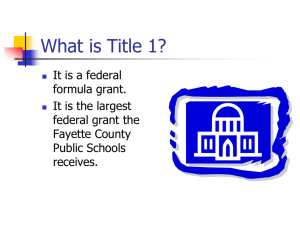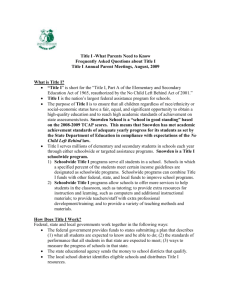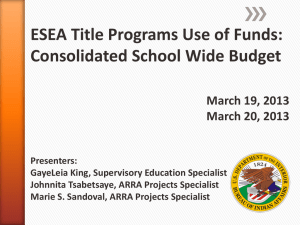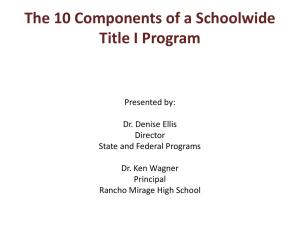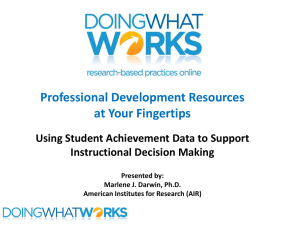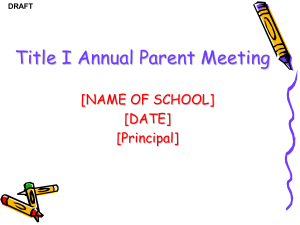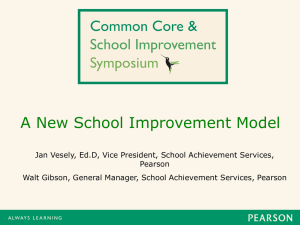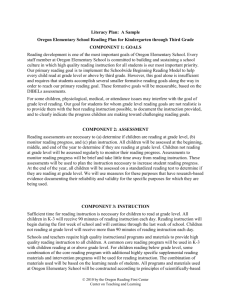Raymond Elementary School
advertisement
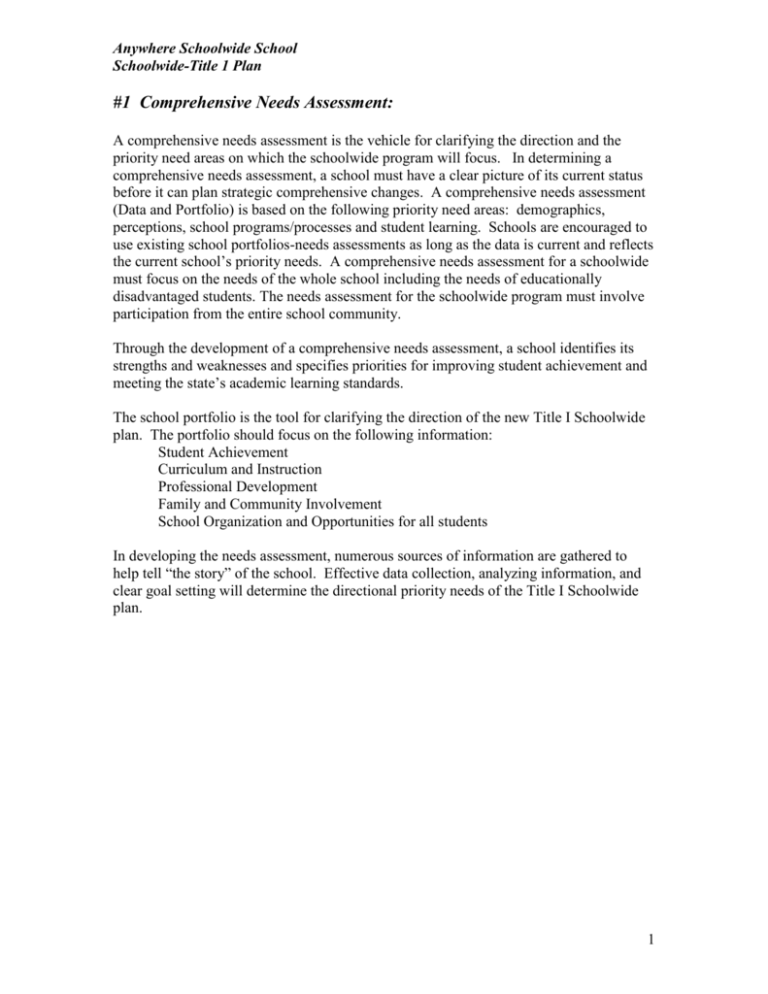
Anywhere Schoolwide School Schoolwide-Title 1 Plan #1 Comprehensive Needs Assessment: A comprehensive needs assessment is the vehicle for clarifying the direction and the priority need areas on which the schoolwide program will focus. In determining a comprehensive needs assessment, a school must have a clear picture of its current status before it can plan strategic comprehensive changes. A comprehensive needs assessment (Data and Portfolio) is based on the following priority need areas: demographics, perceptions, school programs/processes and student learning. Schools are encouraged to use existing school portfolios-needs assessments as long as the data is current and reflects the current school’s priority needs. A comprehensive needs assessment for a schoolwide must focus on the needs of the whole school including the needs of educationally disadvantaged students. The needs assessment for the schoolwide program must involve participation from the entire school community. Through the development of a comprehensive needs assessment, a school identifies its strengths and weaknesses and specifies priorities for improving student achievement and meeting the state’s academic learning standards. The school portfolio is the tool for clarifying the direction of the new Title I Schoolwide plan. The portfolio should focus on the following information: Student Achievement Curriculum and Instruction Professional Development Family and Community Involvement School Organization and Opportunities for all students In developing the needs assessment, numerous sources of information are gathered to help tell “the story” of the school. Effective data collection, analyzing information, and clear goal setting will determine the directional priority needs of the Title I Schoolwide plan. 1 #1 Comprehensive Needs Assessment A. Provide a brief description of your school and the community in which your school is located in order to provide a context for your plan. ___________________________ ____________________________________________________________________ ____________________________________________________________________ B. Needs of all students: Describe how the needs assessment was conducted and how it will address the needs of all students in the school (including regular education, special education, gifted, migrant bilingual, as well as Title 1-with emphasis on a particular focus on the needs of the disadvantaged). Broaden prioritized concerns? ____________________________________________________________________ ____________________________________________________________________ ____________________________________________________________________ C. Describe the challenges of the current program (i.e. high mobility rate, high absenteeism, transition, etc.)_____________________________________________ ____________________________________________________________________ ____________________________________________________________________ D. Review the themes of your program (i.e. math, reading, parent involvement, school climate, etc.) for the Schoolwide program. Show how the themes are aligned to the Nine Characteristics of High Performing Schools, align to the goals of the EALRs and GLEs, and clearly address the needs of the target population in the whole school.______________________________________________________________ ____________________________________________________________________ ____________________________________________________________________ E. An Overview of Your School: Include a description of the school attendance area (i.e. type of neighborhood, economic factors, type of work and availability of such, availability of resources such as library, clinics, and social service agencies). _____ ____________________________________________________________________ ____________________________________________________________________ ____________________________________________________________________ F. Strength of Current Program ____________________________________________ ____________________________________________________________________ ____________________________________________________________________ G. Weakness of Current Program ___________________________________________ ____________________________________________________________________ ____________________________________________________________________ H. Prioritization of Needs: Briefly describe the process used to identify your highest priority areas needing improvement. ______________________________________ ____________________________________________________________________ ____________________________________________________________________ I. Describe the process used to collect and analyze data across the five schoolwide planning dimensions: student achievement, school context and organization, professional development, curriculum and instruction, and family and community involvement. __________________________________________________________ ____________________________________________________________________ ____________________________________________________________________ 2 #2 Schoolwide Reform Strategies: In clarifying needs and finding research-based strategies, the planning team can decide what specific changes in the instructional program and services will need to be made. Understanding the causes of the problems enables team members to use evidence to support their solutions and to tailor solutions to fit specific needs of the schoolwide program. The duties of the team are now to sort out priorities, analyze problems and determine effective goal solutions. The schoolwide team works in the following areas: A. Analyze and determine priority need areas identified to improve student performance; B. Investigate solutions from research and select best practice; C. Select solutions that best fit the local school in recommending meaningful change in the school program. Schoolwide reform strategies: Provide opportunities for all children to meet the state standards and use effective methods and instructional strategies based on scientifically based research that strengthens the core academic program in the school, increase the amount and quality of learning time, include strategies for meeting the educational needs of historically under served populations and strategies to address the needs of all children in the school. Such schoolwide reform strategies that: ` 1. Provide opportunities for all children to meet the state’s student academic standards; 2. Will use effective methods and instructional strategies that are based on research that— a. Strengthens the core academic program in the school; b. Increases the amount and quality of learning time, such as providing extended school year and before and after school programs, summer programs and opportunities, and helps provide an enriched and accelerated curriculum; and c. Includes strategies for meeting the educational needs of the historically underserved populations; 3. Include strategies to address the needs of all children in the school, but particularly the needs of low-achieving children and those at risk of not meeting the state achievement standards who are members of the target population of any program that is included in the schoolwide program. 4. The schoolwide program will address how the school will determine if such needs are being met and consistent with, and designed to implement the state local improvement plans. 3 #2 Schoolwide Reform Strategies: A. List the goals of the Schoolwide program. These goals should be established to meet the needs of all students and ensure that the educationally disadvantaged children are being served effectively in the Schoolwide plan. ___________________________ ____________________________________________________________________ ____________________________________________________________________ ____________________________________________________________________ ____________________________________________________________________ ____________________________________________________________________ B. Base Schoolwide plan on the goal of improving student achievement. _____________ ____________________________________________________________________ ____________________________________________________________________ ____________________________________________________________________ ____________________________________________________________________ ____________________________________________________________________ C. Utilize instructional strategies: (i.e. strategies that will increase the amount and quality of learning time to provide an enriched and accelerated curriculum. _______ ____________________________________________________________________ ____________________________________________________________________ ____________________________________________________________________ ____________________________________________________________________ ____________________________________________________________________ D. Describe the key components of the math and reading instructional program of the school. Describe how the mathematics and reading programs will be organized and delivered to your whole school. ___________________________________________ ____________________________________________________________________ ____________________________________________________________________ ____________________________________________________________________ ____________________________________________________________________ E. Describe the research base or evidence of effectiveness that supports the strategies you have selected. _____________________________________________________ ____________________________________________________________________ ____________________________________________________________________ ____________________________________________________________________ ____________________________________________________________________ F. Describe the components of the instructional program that will meet the needs of the special populations. ____________________________________________________ ____________________________________________________________________ ____________________________________________________________________ ____________________________________________________________________ ____________________________________________________________________ ____________________________________________________________________ 4 #3A Instruction by Highly-Qualified Staff: No Child Left Behind (NCLB) Highly Qualified Teacher Qualifications Requirements 1. Highly qualified teacher qualification requirements of NCLB a. Has earned a least a bachelor’s degree, and b. Holds full state certification, and c. Has demonstated subject matter knowledge and teaching skill in each core academic subject in which the teacher is assigned to teach. Demonstrated competence can be measures through a variety of paths based on the teacher’s education, professional learning experiences and teaching experiences. 2. All teachers with primary responsibility for instruction in one or more of the core academic subject areas must meet the federal definition of highly qualified within the time frame. 3. Core academic subjects are language arts, reading, English, science, mathematics, history, government, geography, economics, arts (music, dance, theatre, visual arts), civics, and foreign language. 4. Timeframe for compliance with federal qualifications requirements: a. Title I Schoolwide or Targeted Assistance Programs: i. Teachers of core academic subjects who are hired after the first day of the 2002-2003 school year and who are teaching in programs supported with Title I funds (schoolwide or targeted assistance) must meet the highly qualified definition at time of hire. ii. Teachers who are working in the programs supported with Title I funds (schoolwide or targeted assistance) prior to the start of the 2002-03 school year and/or teachers who are transferring to such programs within their district have until the end of the 2005-06 school year to meet federal requirements. 5. School districts have a responsibility to support and monitor teacher progress toward meeting the goal of satisfying the federal definition of a highly qualified teacher. They are required to: a. Have a plan to ensure that all teachers meet the definition by the end of the 2005-06 school year. b. Identify teachers that meet this definition(Certified before 1987 or endorsed certificate holders). c. Collect and report annual data reflecting the requirements of OSPI. d. Maintain records at either the school or district level. 5 #3A Instruction by Highly Qualified Teachers (Professional Development Plan) A. Describe the provisions for training teachers, paraeducators, parents and other staff, and explain how the professional development activities will support the Schoolwide program goals. _______________________________________________________ ____________________________________________________________________ ____________________________________________________________________ ____________________________________________________________________ ____________________________________________________________________ ____________________________________________________________________ ____________________________________________________________________ B. Describe how the trainings will coordinate and focus on successful student performance on the State Essential Learnings. _______________________________ ____________________________________________________________________ ____________________________________________________________________ ____________________________________________________________________ ____________________________________________________________________ ____________________________________________________________________ ____________________________________________________________________ C. Describe how activities will ensure that instruction will be provided by highly qualified staff. ________________________________________________________ ____________________________________________________________________ ____________________________________________________________________ ____________________________________________________________________ ____________________________________________________________________ ____________________________________________________________________ ____________________________________________________________________ 6 #3B Instruction by Highly Qualified Paraeducator Staff Washington’s Guideline’s to Fulfill the No Child Left Behind (NCLB) Title I Paraeducator Requirement: Title I, Section 1119(g) states that all paraeducators who are performing instructional duties and are funded with Title I funds, including all paraeducators performing duties in a schoolwide building, must meet specific requirements. The purpose of these requirements is to help ensure the instructional team in providing successful learning experiences for students, particularly students receiving Title I funds. These requirements are: 1. Paraeducators must currently have a secondary school (high school) diploma or its recognized equivalent, and 2. Paraeducators must fulfill one of the following requirements: a. Complete at least two years of study at an institution of higher education; or b. Obtain an associate (or higher) degree; or c. Meet a rigorous standard of quality and can demonstrate, through formal state or local academic assessment, i. Knowledge of, and the ability to assist in instructing reading, writing, and mathematics; or ii. Knowledge of, and the ability to assist in instructing, reading readiness, writing readiness, and mathematics readiness as appropriate. Paraeducators hired prior to or on January 8, 2002, have until January 8, 2006 to meet one of the three requirements listed above. Paraeducators hired after January 8, 2002 must meet one of the three requirements when hired. Options and Pathways to Fulfil Paraeducator Requirement of NCLB: 1. Two years of study at an institution of higher education option; or 2. Associate (or higher) Degree option; or 3. Formal Assessment Option: Common knowledge and skills relative to Washington; a. ETS ParaPro Assessment Pathway; or b. Paraeducator Portfolio Assessment Pathway; or c. School District Paraeducator Assessment Pathway; or d. Paraeducator Apprenticeship Program Pathway 7 #3B Instruction by Highly Qualified Teachers (Professional Development Plan) D. Describe the provisions for training teachers, paraeducators, parents and other staff, and explain how the professional development activities will support the Schoolwide program goals. _______________________________________________________ ____________________________________________________________________ ____________________________________________________________________ ____________________________________________________________________ ____________________________________________________________________ ____________________________________________________________________ ____________________________________________________________________ E. Describe how the trainings will coordinate and focus on successful student performance on the State Essential Learnings. _______________________________ ____________________________________________________________________ ____________________________________________________________________ ____________________________________________________________________ ____________________________________________________________________ ____________________________________________________________________ ____________________________________________________________________ F. Describe how activities will ensure that instruction will be provided by highly qualified staff. ________________________________________________________ ____________________________________________________________________ ____________________________________________________________________ ____________________________________________________________________ ____________________________________________________________________ ____________________________________________________________________ ____________________________________________________________________ 8 #4 Professional Development Activities: In accordance with Section 1119 and subsection (a), highly qualified and ongoing professional development for teachers, principals, paraeducators and, if appropriate, pupil services personnel, parents, and other staff to enable all children in the school to meet the state’s student academic standards. This section should include the professional development plan for the entire school. Regardless of the funding source--regular district funding, or Title I, Title II, and similar No Child Left Behind Title programs--all professional development activities should be focused on successful student performance on the State Essential Learnings (EALR’s). Professional development in a schoolwide program requires: A. The provision of instruction by highly qualified professional staff; B. The support of intensive and sustained professional development C. To inclusion of teachers in decisions regarding the use of the assessments in order to provide information on student performance, and how to improve students’ performance and the overall instructional program. Extrapolate from each action plan together with any district-wide initiatives to create a professional development plan and calendar. A description of how professional development is sustained and how district resources (including Title I set-aside funds) support the school’s professional development. 9 #4 Professional Development Activities: A. List opportunities for on-going professional development. ______________________ ____________________________________________________________________ ____________________________________________________________________ ____________________________________________________________________ ____________________________________________________________________ ____________________________________________________________________ ____________________________________________________________________ B. List enhancements to the educational program for the school year. ______________ ____________________________________________________________________ ____________________________________________________________________ ____________________________________________________________________ ____________________________________________________________________ ____________________________________________________________________ ____________________________________________________________________ C. List how you will provide internal feedback—a tool or mechanism to monitor and adjust the Schoolwide program as needed to better meet the needs of the school community. __________________________________________________________ ____________________________________________________________________ ____________________________________________________________________ ____________________________________________________________________ ____________________________________________________________________ ____________________________________________________________________ ____________________________________________________________________ D. Determine how the team will meet on a regular basis to adjust the program in a timely way if school is not meeting satisfactory progress. ______________________ ____________________________________________________________________ ____________________________________________________________________ ____________________________________________________________________ ____________________________________________________________________ ____________________________________________________________________ ____________________________________________________________________ E. Describe the on-going and embedded support and follow-up to professional development to ensure staff implementation and effective use of the learned instructional skills and strategies. _________________________________________ ____________________________________________________________________ ____________________________________________________________________ ____________________________________________________________________ ____________________________________________________________________ ____________________________________________________________________ ____________________________________________________________________ 10 #5 Attract High-Quality, Highly Qualified Teachers: Section 1114 Schoolwide Programs. The Schoolwide program shall include strategies to attract high-quality, highly qualified teachers to high-need schools. The professional development plan should include a description of strategies used to attract highly qualified staff to work with the most-at-risk students. 11 #5 High-Quality Highly Qualified Teachers: A. List strategies to attract high quality highly-qualified staff. _____________________ ____________________________________________________________________ ____________________________________________________________________ ____________________________________________________________________ ____________________________________________________________________ ____________________________________________________________________ ____________________________________________________________________ B. Do teachers have adequate knowledge and certification to teach and assess their areas or subjects? _____________________________________________________ ____________________________________________________________________ ____________________________________________________________________ ____________________________________________________________________ ____________________________________________________________________ ____________________________________________________________________ ____________________________________________________________________ C. Do teachers receive substantive feedback through periodic observations? _________ ____________________________________________________________________ ____________________________________________________________________ ____________________________________________________________________ ____________________________________________________________________ ____________________________________________________________________ ____________________________________________________________________ 12 #6 Strategies To Increase Parent Involvement: One of the advantages of the schoolwide program is the opportunity to use Title I resources to support activities for all parents. Successful parent involvement requires providing activities that parents value. In exemplary parent involvement programs, parents actively participate in designing, implementing, and at the district or evaluating these activities. No Child Left Behind (NCLB) requires the schoolwide program: A. To ensure a parent involvement policy is place at the district or school level. B. To reinforce strong parent involvement, the plan must include strategies for parental communications, a school-parent-student compact, and procedures for building capacity. A clear description of the process used to communicate with parents of students not meeting standards, as well as the process used to develop and implement the compact, should be included. A copy of the Parent-Teacher-Student compact should be in languages other than English as appropriate. Extrapolate from each action plan and include any current school and district wide initiatives to parent/community involvement in the school. 13 #6 Strategies to Increase Parental Involvement A. Include School-Parent Compact __________________________________________ ____________________________________________________________________ ____________________________________________________________________ ____________________________________________________________________ ____________________________________________________________________ B. Include parent surveys __________________________________________________ ____________________________________________________________________ ____________________________________________________________________ ____________________________________________________________________ ____________________________________________________________________ C. Include strategies for parent communication ________________________________ ____________________________________________________________________ ____________________________________________________________________ ____________________________________________________________________ ____________________________________________________________________ D. Include timeline for parent activities _______________________________________ ____________________________________________________________________ ____________________________________________________________________ ____________________________________________________________________ ____________________________________________________________________ E. Describe any family-support networking strategies ___________________________ ____________________________________________________________________ ____________________________________________________________________ ____________________________________________________________________ ____________________________________________________________________ F. Describe how you are building capacity for involvement _______________________ ____________________________________________________________________ ____________________________________________________________________ ____________________________________________________________________ ____________________________________________________________________ G. Describe links to family health services programs ____________________________ ____________________________________________________________________ ____________________________________________________________________ ____________________________________________________________________ ____________________________________________________________________ H. Describe how progress will be reported to parents ___________________________ ____________________________________________________________________ ____________________________________________________________________ ____________________________________________________________________ ____________________________________________________________________ 14 #7 Transition Plans From Preschool and Between Grade Levels: Under No Child Left Behind (NCLB), coordination of programs and services is a major consideration for the schoolwide program. The following efforts to coordinate with other programs and agencies should include: A. Assisting preschool children in the transition from early childhood programs, such as Even Start, Head Start/ECEAP, Pre-kindergarten, or the Title I preschool program, to local elementary school programs; and assisting students in transition between grade levels and schools. B. Developing the schoolwide program plan in coordination with programs under NCLB, Violence Prevention programs, nutrition programs, housing programs, Head Start, adult education, vocational and technical education, and job training. C. Coordinating and integrating parent involvement activities with other programs. The key element of the transition plan is to develop plans to help preschool children from early childhood programs to elementary school and other related program transitions. 15 #7 Transition Plans For Preschool and Between Grade Levels A. Describe how you will assist all district programs in transition between programs and schools (include preschool and other related program transitions). __________ ___________________________________________________________________ ___________________________________________________________________ ___________________________________________________________________ ___________________________________________________________________ ___________________________________________________________________ ___________________________________________________________________ B. Describe other transitions that may be applicable to your schools, such as elementary to middle school, middle school to high school, and high school to postsecondary. __________________________________________________________ ___________________________________________________________________ ___________________________________________________________________ ___________________________________________________________________ ___________________________________________________________________ ___________________________________________________________________ ___________________________________________________________________ C. Describe on-going coordination with other programs and agencies. ____________ ___________________________________________________________________ ___________________________________________________________________ ___________________________________________________________________ ___________________________________________________________________ ___________________________________________________________________ ___________________________________________________________________ 16 #8 Teacher Included In Assessment Decisions: Accountability for the schoolwide program is the same for all schools. The basis for evaluation is student progress as demonstrated on the state’s assessment system which is aligned with challenging content and performance standards. The law requires that the schoolwide program include teachers in decisions regarding the use of additional assessments in order to provide information on, and to improve, students’ performance and the overall instruction program. Washington State Assessment System (WASL, ITBS, ITED) provides the foundation layer for program evaluation. The plan should describe how assessment will be reported to parents. 17 #8 Teachers Included In Assessment Decisions A. Describe measures utilized to include all teachers in the assessment decision. ______ ____________________________________________________________________ ____________________________________________________________________ ____________________________________________________________________ ____________________________________________________________________ B. Describe how student progress is aligned to the state’s assessment system and is aligned to the standards (i.e. Curriculum Mapping strategies for alignment to state standards). ___________________________________________________________ ____________________________________________________________________ ____________________________________________________________________ ____________________________________________________________________ ____________________________________________________________________ C. Describe how assessment will improve instructional practices. __________________ ____________________________________________________________________ ____________________________________________________________________ ____________________________________________________________________ ____________________________________________________________________ D. Describe the procedures for measuring and reporting annual student progress. ____ ____________________________________________________________________ ____________________________________________________________________ ____________________________________________________________________ ____________________________________________________________________ E. Describe how and when the on-going implementation of the schoolwide program will be evaluated and adjusted as needed. ______________________________________ ____________________________________________________________________ ____________________________________________________________________ ____________________________________________________________________ ____________________________________________________________________ F. Describe the process to be used by the school and district to annually review and update the schoolwide plan to ensure that progress is being made toward the goals of the plan. _____________________________________________________________ ____________________________________________________________________ ____________________________________________________________________ ____________________________________________________________________ ____________________________________________________________________ 18 #9 Strategies For Providing Timely Additional Assistance To Students Experiencing Difficulties Mastering Standards: The schoolwide reform strategies for assisting students who experience difficulty mastering the proficient or advanced levels of the academic achievement standards required by Section 111(b) (1) shall be provided with effective, timely, additional assistance which shall include measures to ensure that students’ difficulties are identified on a timely basis and to provide sufficient information on which to base effective assistance. Strategies for providing timely, additional assistance to students experiencing difficulties mastering standards (disadvantaged, minorities, ESL, disabilities and other students-at risk). Include strategies that : 1. Encourage systematic change to the current instructional program to help disadvantaged students and the whole school population. 2. Base strategies on results from assessments, research literature, visits to other programs, professional staff development activities, workshop, or classes. 3. Based on results that have been analyzed with prioritized needs 4. Use the core team to pull all parts together in a coherent program plan. 19 #9 Providing Assistance to Students Experiencing Difficulty A. Description of the process used to identify students experiencing difficulty meeting standards.___________________________________________________________ ____________________________________________________________________ ____________________________________________________________________ ____________________________________________________________________ ____________________________________________________________________ ____________________________________________________________________ ____________________________________________________________________ B. Describe strategies for providing timely assistance to students experiencing difficulties mastering standards.__________________________________________ ____________________________________________________________________ ____________________________________________________________________ ____________________________________________________________________ ____________________________________________________________________ ____________________________________________________________________ ____________________________________________________________________ 20 #10 Coordinated and Integrated Federal, State and Local Services: A schoolwide program shall include coordination and integration of Federal, State, and local services and programs, including programs supported under this NCLB Act, violence prevention programs, nutrition programs, housing programs, Head Start, adult education, vocational and technical education, and job training. The schoolwide program is required to include: A. A list of the local, state, and federal programs included in the schoolwide model for flexibility of fiscal accountability. B. How Title I funds and funds from other sources will be used to implement the schoolwide plan. C. How Title I funding will supplement state and local funding. D. Provide a brief budget narrative explaining how funds listed in the table will be used to support the schoolwide plan. 21 #10 Coordinated and Integrated Federal, State and local services A. Describe Title 1 funds and funding from other sources that will be used to implement the Schoolwide plan. ___________________________________________________ ____________________________________________________________________ ____________________________________________________________________ ____________________________________________________________________ B. Complete a narrative list of all technical assistance providers who have helped to develop the School plan. ________________________________________________ ____________________________________________________________________ ____________________________________________________________________ ____________________________________________________________________ C. Explanation of how funds support schoolwide program goals. __________________ ____________________________________________________________________ ____________________________________________________________________ ____________________________________________________________________ D. Budget narrative explains how funds will support the schoolwide effort. __________ ____________________________________________________________________ ____________________________________________________________________ ____________________________________________________________________ 22 REVENUES FOR SCHOOLWIDE PROGRAMS Federal Revenues The Secretary of Education authorizes a schoolwide program school (building) to use funds or services that the school receives from certain federal education programs administered by the Secretary to upgrade its entire educational program as long as the intent and purposes of each program are met. Federal programs that may be consolidated in schoolwide programs include: Title I, Part A of ESEA: Improving the Academic Achievement of the Disadvantaged Title I, Part B-3 of ESEA: Even Start Family Literacy Programs Title I, Part C of ESEA: Education of Migratory Children (See exception #3) Title I, Part D of ESEA: Prevention and Intervention Programs for Children and Youth Who are Neglected, Delinquent, or At-Risk (See exception #4) Title II of ESEA: Preparing, Training and Recruiting High Quality Teachers and Principals Title II, Part D of ESEA: Enhancing Education Through Technology Title III of ESEA: Language Instruction for Limited English Proficient and Immigrant Students Title IV, Part A of ESEA: Safe and Drug-Free Schools Program Title V, Part A of ESEA: Innovative Programs Title VII of ESEA: Indian, Native Hawaiian, and Alaska Native Education (See exception #5) Title VIII of ESEA: Impact Aid Individuals with Disabilities Education Act (IDEA), Part B (See exception #1) Title X Stewart B. McKinney Homeless Assistance Act: Education for Homeless Children and Youth Carl D. Perkins Vocational and Applied Technology Act 23
